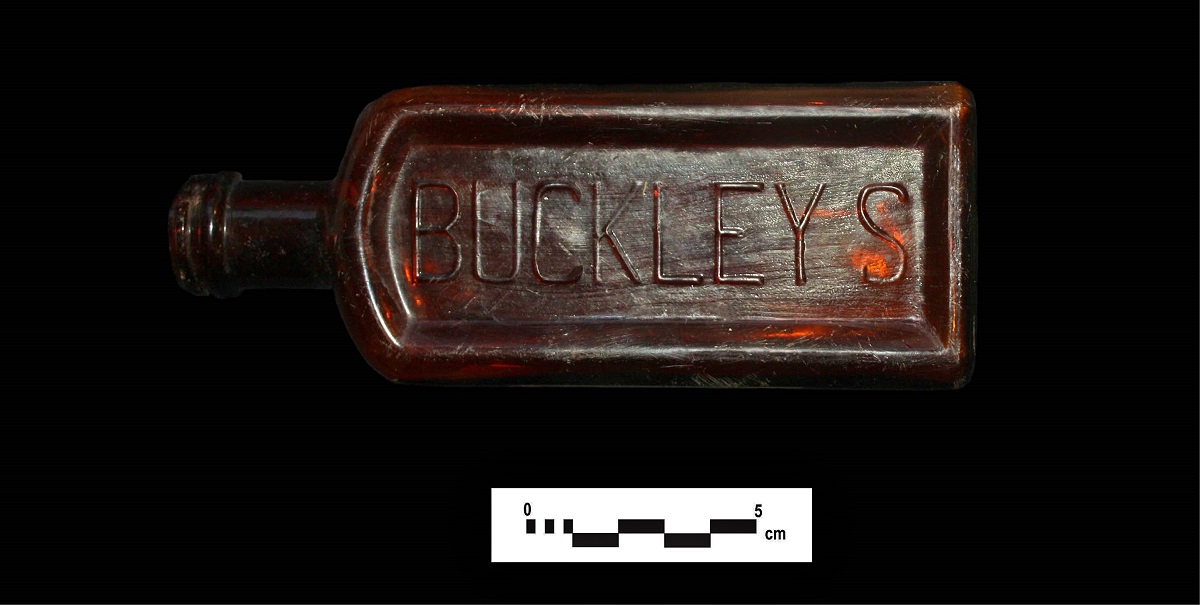These days, as winter slowly melts into spring and cold and flu bugs pop up, we take runny noses and flu symptoms as they come. “No big deal,” we tell ourselves, often falsely. Get a flu shot, buy some pills….done.
There was a time, however, when viral respiratory infections such as colds and flu were a serious matter for not only the young and the old, but for healthy adult Canadians. There was very little one could do for prevention or a cure, unlike today.
This week’s Featured Artifact is very familiar to both modern Canadians and those in the past. In the wake of one of the deadliest human health crises of the modern era, many embraced this Canadian concoction infamous for its horrible flavour. In 1919, Toronto pharmacist William Knapp Buckley bought a pharmacy and by March of 1920 he had discovered several natural ingredients that had a positive impact on cold and flu; Buckley’s Mixture was born. It became extremely popular in Canada and many parts of the world (see picture above, circa 1930s, found during recent excavations east of Toronto by ASI staff).
During the Great Depression when money was tight, Buckley’s kept the price at an affordable 40 cents per bottle. The bottle’s brown glass limited the amount of natural light passing through the bottle, thus limiting light’s deleterious effects.

Buckley’s legitimate business model was a far cry from many of the tonics, cures and nostrums that flooded the market early in the 20th century. Over 50,000 questionable products aimed at curing every ill were flying off the shelves – largely because of their addictive ingredients rather than any legitimate health benefit. Unscrupulous businessmen were making millions of dollars in profits from these mixtures. Scholars suggest that, in 1905, these manufacturers’ profits totaled the equivalent of two billion dollars today.
From the 1870s onward, many of these products contained worrying amounts of alcohol, chloroform, opiates and cannabis. Many deaths were blamed on their addictive and hallucinatory nature. Men were falling into machinery at work and on the farm. Steam train engineers were hallucinating. Although women’s temperance groups tried to raise the alarm, it wasn’t until 1905 that people and governments began to recognize the dangers, due in large part to a series of magazine articles. In that year, the US government first banned the mailing of fraudulent medicines. In 1907 the use of the word “cure” was discouraged (many infamous elixirs simply switched to the word “remedy”) and the United States government acted, albeit slowly over the next few decades, to regulate the products. This action was mirrored worldwide.
The impact of the exposure of patent medicines, plus a devastating human health storm on the horizon, changed the medical world forever.
In 1917, the British military “mobilized” over 90,000 Chinese labourers to work behind British and French lines during the Great War. Sadly, these workers brought with them a strain of flu from northern China. Soldiers returning from the front, in turn, introduced this flu to their homelands, unleashing Spanish influenza. The Spanish flu pandemic struck in two killer waves over two years, affecting 500 million people worldwide and killing between 50-100 million. Fifty-thousand deaths occurred in Canada alone.
It was, in part, the sale of fraudulent medicines and the Spanish flu pandemic that helped fuel medical research in the 1920s and 1930s, leading to the development of such respectable and reputable treatments as Buckley’s Mixture.
Today, Canadians still reach for Buckley’s. Children typically catch eight colds a year, while adults and seniors may catch four and two colds, respectively. Depending on the severity of flu season, 20,000 people per year may be hospitalized. The flu claims 4,000 to 8,000 Canadians annually, and these deaths occur primarily among the very young and old.
The Buckley’s bottle may look different today, but its mixture of Canada balsam and pine needles (among other things) has never changed. As the 1980s award-winning ad slogan states: “It tastes awful. And it works.”









